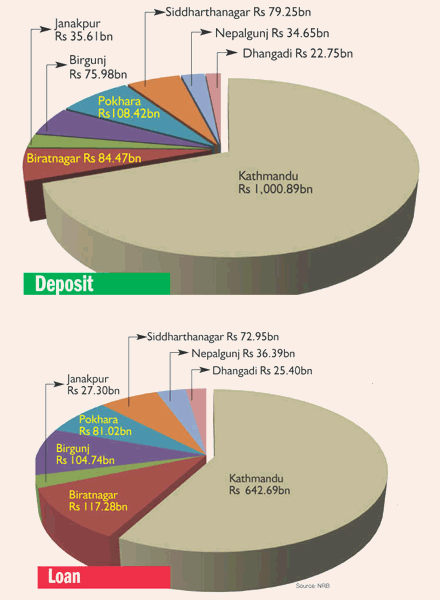Banks and financial institutions (BFIs) collect almost 68 per cent of deposits from Kathmandu Valley and extend around 56 per cent of loans to borrowers based in the Capital, indicating that financial services are not easily available to people living outside the Valley.
BFIs collected Rs 1.44 trillion in deposits and extended Rs 1.11 trillion in loans till the end of last fiscal year in mid-July. Of this, deposits worth Rs 973.31 billion were collected from the Valley, while loans worth Rs 621.53 billion were issued to borrowers based here, shows a latest report of Nepal Rastra Bank.
What is even more surprising is that branches of BFIs located in Kathmandu district alone collected Rs 838.90 billion in deposits, making a contribution of whopping 58.17 per cent to the total deposit collection. Similarly, borrowers based in the district obtained Rs 565.22 billion in credit, which was 51 per cent of total loans extended by BFIs throughout the country, shows the Economic Activities Study Report made public today by NRB. However, the data on credit extension may not reflect true picture as loans of bigger sizes generally require approval of head offices many of which are based in Kathmandu.
These data clearly show that financial services are concentrated in Kathmandu Valley, especially Kathmandu district.
On the contrary, five districts in the far west region — Kailali, Kanchanpur, Dadeldhura, Doti and Baitadi — saw collection of Rs 22.75 billion in deposits and dissemination of Rs 25.40 billion in loans. The contribution of these districts in total deposit collection and loan extension stood at mere 1.58 per cent and 2.29 per cent, respectively.
Yet, what is encouraging is that these districts are witnessing impressive deposit and credit growth rates. Kanchanpur, for instance, saw 35 per cent increment in deposits to Rs 6.43 billion in last fiscal, while Dadeldhura witnessed 34.08 per cent hike in deposits to Rs 1.72 billion.
In terms of loans, Dadeldhura recorded credit growth of 86.78 per cent to Rs 952.42 million in last fiscal, while Doti saw credit growth of 45.29 per cent to Rs 620.34 million in same period.
Though these growth rates are impressive, nominal contribution of these districts in total deposit and loans indicates BFIs are keen on serving affluent areas, rather than regions like the far west, where incidence of poverty is high. Also noteworthy is that microfinance institutions, whose sole purpose is to serve low-income and marginalised groups, are not too interested in setting up shops in far west region.
The region, as of last fiscal year, saw presence of only 49 branches of microfinance development banks, as against 170 in Biratnagar area and 94 in Kathmandu. In total, 765 branches of microfinance development banks were operating in the country. Similarly, 1,417 branches of commercial banks, 771 of development banks and 234 of finance companies were catering services throughout country till end of last fiscal.
Source: the himalayan times, 9 dec 2014
LINK
BFIs collected Rs 1.44 trillion in deposits and extended Rs 1.11 trillion in loans till the end of last fiscal year in mid-July. Of this, deposits worth Rs 973.31 billion were collected from the Valley, while loans worth Rs 621.53 billion were issued to borrowers based here, shows a latest report of Nepal Rastra Bank.
What is even more surprising is that branches of BFIs located in Kathmandu district alone collected Rs 838.90 billion in deposits, making a contribution of whopping 58.17 per cent to the total deposit collection. Similarly, borrowers based in the district obtained Rs 565.22 billion in credit, which was 51 per cent of total loans extended by BFIs throughout the country, shows the Economic Activities Study Report made public today by NRB. However, the data on credit extension may not reflect true picture as loans of bigger sizes generally require approval of head offices many of which are based in Kathmandu.
These data clearly show that financial services are concentrated in Kathmandu Valley, especially Kathmandu district.
On the contrary, five districts in the far west region — Kailali, Kanchanpur, Dadeldhura, Doti and Baitadi — saw collection of Rs 22.75 billion in deposits and dissemination of Rs 25.40 billion in loans. The contribution of these districts in total deposit collection and loan extension stood at mere 1.58 per cent and 2.29 per cent, respectively.
Yet, what is encouraging is that these districts are witnessing impressive deposit and credit growth rates. Kanchanpur, for instance, saw 35 per cent increment in deposits to Rs 6.43 billion in last fiscal, while Dadeldhura witnessed 34.08 per cent hike in deposits to Rs 1.72 billion.
In terms of loans, Dadeldhura recorded credit growth of 86.78 per cent to Rs 952.42 million in last fiscal, while Doti saw credit growth of 45.29 per cent to Rs 620.34 million in same period.
Though these growth rates are impressive, nominal contribution of these districts in total deposit and loans indicates BFIs are keen on serving affluent areas, rather than regions like the far west, where incidence of poverty is high. Also noteworthy is that microfinance institutions, whose sole purpose is to serve low-income and marginalised groups, are not too interested in setting up shops in far west region.
The region, as of last fiscal year, saw presence of only 49 branches of microfinance development banks, as against 170 in Biratnagar area and 94 in Kathmandu. In total, 765 branches of microfinance development banks were operating in the country. Similarly, 1,417 branches of commercial banks, 771 of development banks and 234 of finance companies were catering services throughout country till end of last fiscal.
Source: the himalayan times, 9 dec 2014
LINK

Comments
Post a Comment